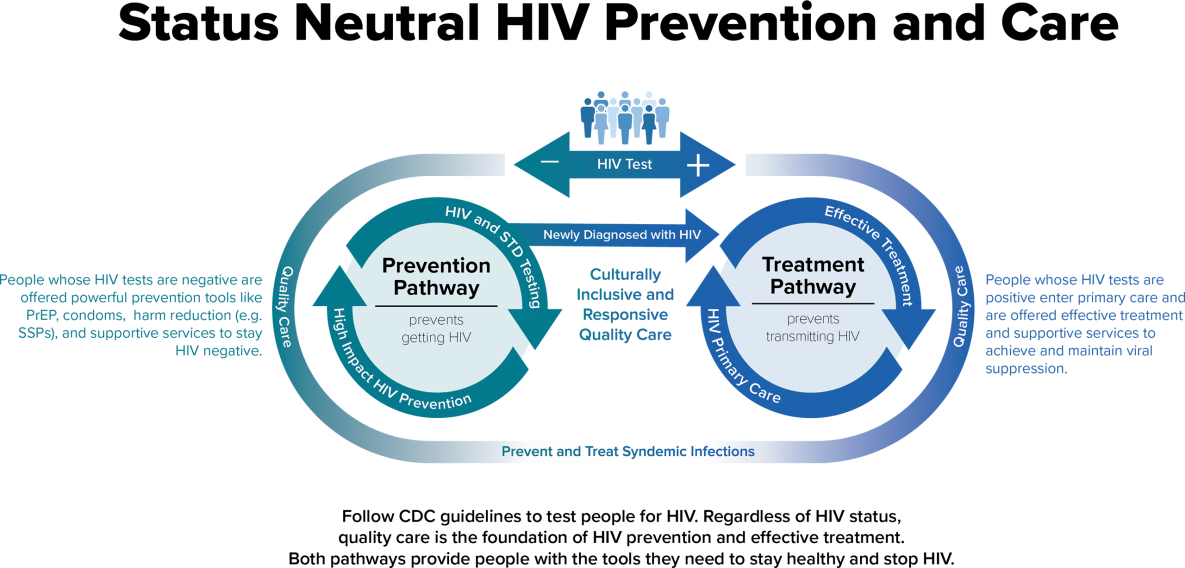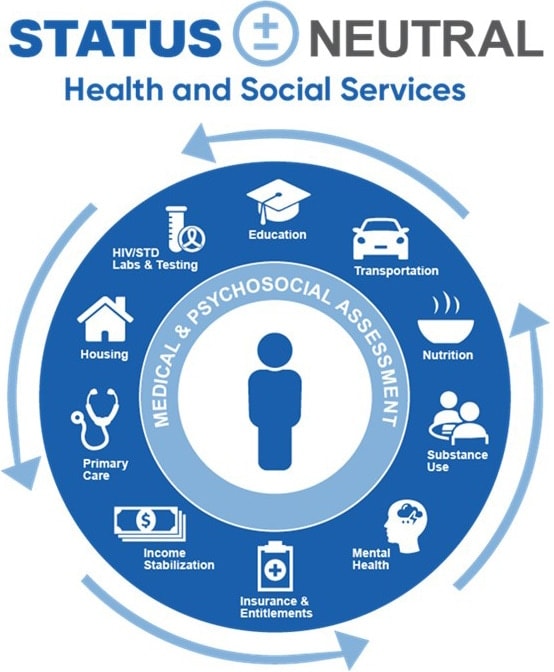Status Neutral HIV Prevention and Care
Status Neutral HIV Prevention and Care, or Status Neutrality, is a whole person approach to HIV prevention and care that emphasizes high-quality care to engage and retain people in services regardless of if the services are for HIV treatment or prevention. A status neutral approach continually addresses the healthcare and social service needs of all people affected by HIV so that they can achieve and maintain optimal health and well-being.

About Status Neutral HIV Prevention and Care
Status Neutral HIV Prevention and Care was first introduced by the New York City Department of Health and Mental Hygiene as a comprehensive system of prevention that includes all people affected by HIV, regardless of their HIV status. With a status neutral approach, engaging and assessing the client’s needs begins before an HIV test is conducted. Considered a whole person approach to health care and service delivery, status neutral HIV prevention and care focuses on the needs of the person through provision of comprehensive services that meet people where they are regardless of their HIV status.
Status neutrality seeks to address social and structural barriers to engagement in biomedical prevention (e.g., PrEP) and HIV care and treatment (e.g., ART). A status neutral approach prioritizes opportunities to address the needs of everyone in a community by providing or linking to comprehensive, state-of-the-art sexual health and supportive services. Ultimately, status neutral approaches promote health equity by putting client needs above HIV status to improve care and eliminate stigma.
The status neutral approach to HIV prevention and care defines the entry point to care as the time of an HIV test. At this entry point, clients’ needs are assessed, and they are engaged and linked to appropriate services based on these needs, regardless of whether their HIV test is positive or negative. This status neutral approach modifies the step-by-step care continuum from a disease-specific, linear approach to a whole person, needs-based approach.
Social determinants of health impact risk of acquiring HIV. The status neutral approach aims to provide “comprehensive support and care to address the social determinants of health that create disparities, especially as they relate to HIV.” Working in communities to expand availability of and access to interventions and services that address the needs of all community members reflects a status neutral approach. Such offerings might include safe, stable housing, mental health services, food security, legal support, and syringe services programs. Individuals from communities disproportionately affected by HIV should be able to access or easily navigate priority services without requiring an HIV test first. Status neutral approaches recognize the influence of social determinants of health and prioritize innovative, person-focused care to address not only HIV prevention and treatment, but also to address all barriers to staying healthy. The Status Neutral Health and Social Services graphic, from ETR, highlights the holistic offerings consistent with a status neutral approach.
To learn more about status neutral HIV prevention and care, please view the CDC Issue Brief: Status Neutral HIV Care and Service Delivery Eliminating Stigma and Reducing Health Disparities.
Intervention Goals
Minimizing stigma by taking a whole person approach to prevention and care
- Eliminating Stigma
- Making Services More Accessible
- Helping People Achieve Optimal Health and Well-being
- Efficiencies in Service Delivery
- Greater Health Equity
Status Neutral HIV Prevention and Care Core/Essential Elements
- Offer whole person, holistic services
- Provide prevention, care, and treatment services regardless of HIV status
Status Neutral HIV Prevention and Care Priority Population
- All persons affected by HIV
Status Neutral HIV Prevention and Care Training
This training has 1 component:
- 20-minute eLearning module
To access eLearning modules, including training prerequisite courses:
- Log-in to CDC TRAIN and access the HIV CBA Training Plan (step-by-step instructions are available).
- Select the module you wish to take.
- Launch the module or save the module for later.
Technical assistance for the implementation of Status Neutral HIV Prevention and Care is available.
To request technical assistance:
- CDC’s directly funded health department and CBO partners may request technical assistance support by submitting a request in the CBA Tracking System.
- Organizations not directly funded by CDC may contact their local health department for assistance in submitting a training request.
If you have questions or need additional assistance, please contact HIVCBA@cdc.gov.
- Achieving Together Texas. A Status Neutral Approach: Achieving Together to End the HIV Epidemic. AchievingtogetherTexas.org. Published June 18, 2020. Accessed September 7, 2022.
- DC Beings. HIV Status Neutral. Published May 27, 2021. Accessed September 7, 2021.
- District of Columbia Department of Health. Status Neutral. Sex Positive. Published August 31, 2021. Accessed September 7, 2021.
- Dubin S. ‘If We Do This Right’ Maybe H.I.V. Will Be Forgotten. The New York Times. Published June 12, 2019. Accessed September 7, 2022.
- Mayer K, Nelson L, Hightow-Weidman L, et al. The persistent and evolving HIV epidemic in American men who have sex with men. The Lancet 2021;397: 1116–26.
- Myers JE, Braunstein SL, Xia Q, et al. Redefining prevention and care: A status-neutral approach to HIV. Open Forum Infect Dis. 2018;5(6). doi:10.1093/ofid/ofy097.
- New York City Department of Health and Mental Hygiene. New York City: Ending the HIV Epidemic: A Plan for America Plan. NYhiv.org. Published March 29, 2021. Accessed September 7, 2021.
- Rangel JC, Crath R. Managing risk, managing affects: The emerging biopolitics of HIV neutrality. Health Risk Soc. 2021;23(5-6):251-271. doi:10.1080/13698575.2021.1972088.



